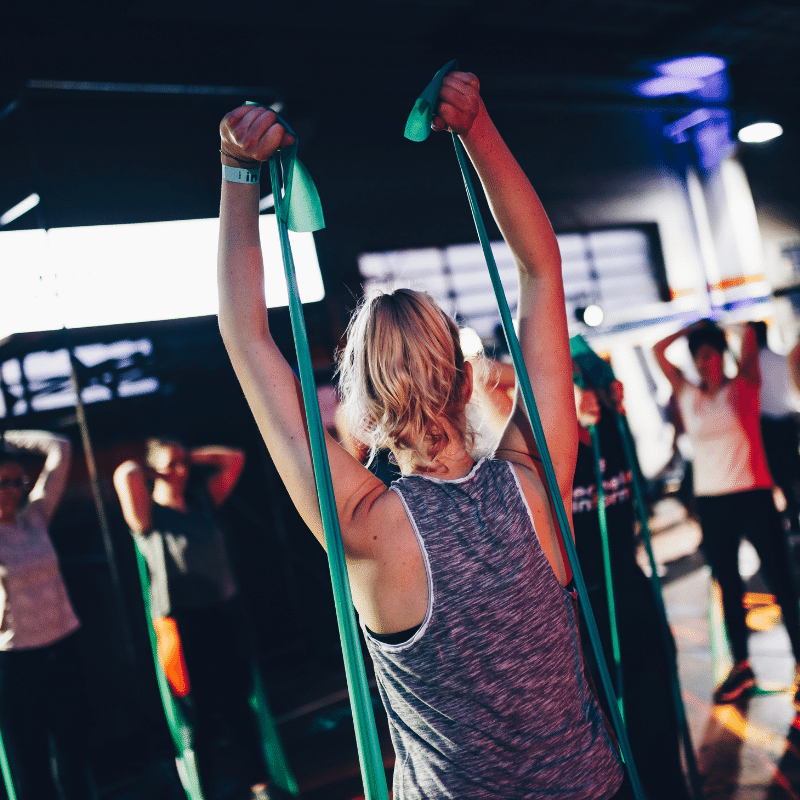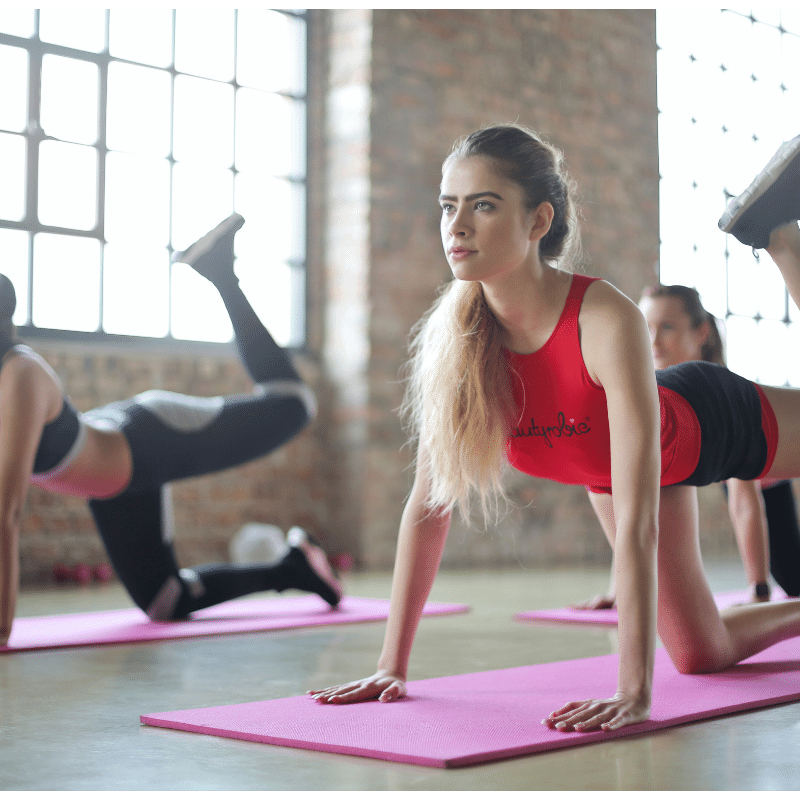Calisthenics are the most well-rounded exercise system you will find. The results of your workouts are visible within weeks!
Welcome to the world of calisthenics – a fitness journey that will challenge and transform your body in ways you never thought possible! Whether you’re a beginner looking for an effective way to build strength or someone seeking a new workout routine, calisthenics is here to revolutionize your fitness game.
But what exactly is calisthenics? In simple terms, it’s a form of exercise that utilizes bodyweight movements to improve strength, flexibility, and overall physical fitness. You only need yourself, your willpower, and the force of gravity – no fancy equipment or gym memberships are required!
In this blog post, we’ll dive deep into the world of calisthenics workouts for beginners. We’ll explore the benefits of this incredible training method, discuss exercises you can incorporate into your routine, and provide step-by-step guidance on getting started. So, let’s strap on our workout shoes and embark on this exciting journey together!

What is Calisthenics?
Calisthenics is more than just a workout – it’s a lifestyle. It focuses on utilizing your body weight to build strength, improve flexibility, and enhance overall fitness. Unlike traditional weightlifting or cardio exercises, calisthenics emphasizes functional movements that mimic real-life activities.
One of the critical principles behind calisthenics is the idea of progressive overload. This means gradually increasing the difficulty of an exercise over time to challenge your muscles and stimulate growth continually. From push-ups and squats to pull-ups and planks, countless variations of calisthenic exercises target different muscle groups.
The beauty of calisthenics lies in its versatility – you can perform these exercises virtually anywhere, whether at home, in a park, or even while traveling. You can Manage your workout intensity by adjusting repetitions, sets, rest periods, and tempo.
Not only does calisthenics help you develop physical strength and endurance, but it also enhances motor skills like balance and coordination. It promotes full-body engagement rather than isolating specific muscles, leading to functional gains that carry over into everyday activities.
So, if you’re ready to ditch the machines and weights for a more natural approach to fitness, try calisthenics! Embrace this exciting exercise that challenges your mind and body while allowing you to unlock your true potential.
Exploring Top Alternatives to First Row Sports for Online Sports Streaming
The Benefits of Calisthenics
Calisthenics, often referred to as bodyweight training, is a form of exercise that uses only the weight and resistance of your own body. It requires no equipment or gym membership, making it an accessible and affordable option for anyone looking to improve their fitness level.
One of the critical benefits of calisthenics is it is ability to build strength and muscle mass. You engage multiple muscle groups at once by performing exercises like push-ups, squats, and lunges, leading to overall strength gains.

In addition to building strength, calisthenics also improves flexibility and mobility. Exercises such as yoga-inspired flows and dynamic stretches help increase your range of motion and joint stability.
Another advantage of calisthenics is its effectiveness in improving cardiovascular fitness. With high-intensity movements like burpees or mountain climbers incorporated into your routine, you can elevate your heart rate and boost endurance levels.
Unlike traditional weightlifting routines that may focus on isolated muscles, calisthenics promotes functional movement patterns that mimic real-life activities. This translates into improved performance in everyday tasks such as lifting objects or climbing stairs.
Moreover, calisthenics workouts are highly adaptable and scalable. Whether you’re a beginner starting with modified variations or an advanced athlete challenging yourself with advanced progressions, there’s always room for growth within this discipline.
Lastly – though certainly not exhaustively – calisthenics can be a great way to achieve aesthetic goals. You’ll notice muscle definition and overall physique improvements as you develop lean muscle mass through bodyweight exercises.
With all these benefits combined – from increased strength and flexibility to improved cardiovascular health – it’s clear why many individuals are turning to calisthenics as their go-to workout routine! So why not give it a try? You might discover a new passion while reaping numerous rewards for mind and body!
Different Types of Calisthenics Workouts
Different Types of Calisthenics Workouts
Regarding calisthenics workouts, You can Include a wide range of exercises in your regimen, including bodyweight exercises that utilize your weight as resistance, such as push-ups, squats, lunges, and planks.
Another type of calisthenics workout is plyometrics. This involves volcanic movements such as jump squats or box jumps, which help to increase power and speed. Plyometrics are great for athletes looking to boost their performance in basketball or soccer.
If you’re looking for a more challenging workout, gymnastics-based calisthenics might be the right choice. These workouts involve moves like handstands, muscle-ups, and front levers. They require incredible upper-body strength and coordination but can lead to stirring gains in muscle mass and overall fitness.

Circuit training presents a fantastic choice for individuals who are looking who prefer a more cardio-focused workout. It combines different types of back-to-back exercises with little rest between sets. This training style keeps your heart rate elevated throughout the session while simultaneously targeting multiple muscle groups.
One unique form of calisthenics worth mentioning is animal flow workouts. Inspired by primal movement patterns observed in animals such as bears or crabs, these routines involve crawling movements and dynamic stretches that improve mobility and stability.
Incorporating different types of calisthenic workouts into your routine helps prevent boredom and ensures well-rounded development across all aspects of fitness – from strength-building to cardiovascular endurance. So go ahead and mix things up – try out various styles until you find what works best for you!
How to Get Started with Calisthenics
Getting started with calisthenics may initially seem intimidating, but it doesn’t have to be. Anyone can do it if they have the right plan and attitude dive into this exciting form of exercise and start building strength and fitness.
It’s important to understand that calisthenics is a bodyweight-based workout method that uses your weight for resistance. This means you don’t need fancy equipment or weights to get started. All you need is your own body and some determination!
To begin your calisthenics journey, start by assessing your current fitness level. This will help you determine where to start and set realistic goals. Progress takes time, so be patient with yourself as you build strength.
Next, familiarize yourself with basic exercises such as push-ups, squats, lunges, planks, and burpees. These foundational movements are essential in developing overall strength and stability.
Prioritizing proper form over quantity is crucial when performing these exercises. Concentrate on maintaining proper posture and correct muscles throughout each movement to maximize effectiveness while minimizing the risk of injury.

In addition to mastering the basics, consider incorporating flexibility training into your routine. Stretching before and after exercise can enhance performance. mobility and prevent muscle imbalances.
Lastly (but certainly not least), remember that consistency is critical! Aim for regular workouts – initially 2-3 times per week – gradually increasing intensity as you progress.
By following these steps and staying committed to your calisthenics practice, you’ll soon experience improvements in strength, endurance, balance, and overall fitness levels. So don’t hesitate any longer – take that first step towards embracing calisthenics today!
Beginner-friendly Calisthenics Workouts
If you’re new to calisthenics and looking for beginner-friendly workouts, you’ve come to the right place! Calisthenics is a great way to use your own body weight to get stronger and more fit. It’s a flexible way to work out that you can change to fit your fitness level and goals. There are a lot of choices for people who are new to gymnastics, even if they have done other kinds of exercise before.
One important thing to remember as a beginner is proper form. Focus on mastering the basic movements before progressing to more advanced exercises. Start with foundational exercises like squats, lunges, planks, and pull-ups. You can get stronger in your core, legs, arms, chest, and back by doing these routines.
To make your workouts more challenging as you if you want to make growth, try doing more reps or sets for each exercise. You can also incorporate variations of these movements, such as diamond or assisted pull-ups.
Another critical aspect of building strength through calisthenics is consistency. Aim for at least three sessions per week and gradually increase the duration as you become more comfortable with the exercises.

Remember to listen to your body and take rest days when needed. Overtraining can hurt you and stop you from getting better.
A well-balanced diet that helps muscles grow and heal is just as important as working out regularly. Make sure you eat enough fruits, veggies, whole grains, and foods that are high in protein.
By incorporating these beginner-friendly calisthenics workouts into your routine, along with proper nutrition, you’ll be well on your way towards building strength, fostering endurance, and achieving overall wellness.
Conclusion
The journey of building strength and fitness through calisthenics is just beginning. As you dive into this world of bodyweight exercises, the possibilities are endless. With each new workout, you’ll challenge your muscles, improve your flexibility, and push yourself to new limits.
Calisthenics offers a range of benefits that go beyond just physical strength. It builds coordination, improves balance, and enhances overall athleticism. Plus, it can be done anywhere without fancy equipment or gym memberships.
There are various types of calisthenics workouts to explore based on your goals and preferences. Whether targeting specific muscle groups or looking for full-body routines, there’s something for everyone.
Getting started with calisthenics may initially seem intimidating, Don’t worry, though, because everyone has to start somewhere! Begin with beginner-friendly workouts focusing on mastering basic movements like squats, push-ups, planks, and lunges. Take it slow and gradually increase intensity as you build confidence and strength.
To create your calisthenics workout plan, consider incorporating exercises that target different areas, such as upper body (push-ups), lower body (squats), core (plank variations), and cardio (jumping jacks). Mix up the exercises to keep things interesting while challenging yourself in new ways.
Remember to listen to your body throughout your calisthenics journey. Rest days are as important as training to Let your muscles heal and get stronger by giving them time to do so.
So what are you waiting for? Start exploring the world of calisthenics today and unleash the power within you!

Calisthenics Back Workout
Calisthenics Back Workout:
When building a strong and defined back, calisthenics exercises can be efficient. Not only do they work a lot of back muscles, but they also work your core, which helps you stay stable and balanced.
One of the best calisthenics exercises for the back is the pull-up. This compound movement simultaneously works your lats, traps, rhomboids, and biceps. If you’re starting and find pull-ups challenging, don’t worry! You can modify this exercise by using resistance bands or performing assisted pull-ups on a machine.
Another excellent exercise for your back is the inverted row. All you need is a barbell or suspension trainer to perform this move. Lie underneath the bar or suspension trainer with your feet extended in front of you. Grab onto the bar/trainer with an overhand grip and keep your body straight as you pull yourself up towards it.
Incorporate exercises like superman’s or reverse hyperextensions into your routine to specifically target your lower back muscles. These movements help strengthen not only your lower back but also improve overall spinal stability.
Always maintain proper form during these workouts to prevent injury and maximize results. Focus on the squeezing your shoulder blades together during each rep to use your back muscles fully.
Adding these fitness exercises to your workout routine will help you build a stronger and more defined back in no time if you are consistent and work hard. So get ready to feel great in that tank top!
Calisthenics Leg Workout
Calisthenics Leg Workout
When it come to building strength and fitness, leg workouts are a crucial component. Calisthenics offers a range of exercises that target your lower body muscles, helping you to develop strong and toned legs.
One effective calisthenics exercise for the legs is the squat. Squats engage multiple muscle groups, including quadriceps, hamstrings, glutes, and calves. To perform a basic To To hunch over pose with your toes shoulder-width apart and squat down as if you were sitting back in a chair. Make sure your chest is up and your knees are touching your toes.
Another excellent exercise for leg strength is lunges. Lunges work your quads, hamstrings, glutes, and calves while improving balance and stability. Stand with one foot forward and the other back in a split stance position. Lower your back knee towards the ground while keeping both knees at 90-degree angles.
Try incorporating plyometric exercises like jump squats or box jumps to add intensity to your leg workout routine. These explosive movements not only build muscular power but also enhance cardiovascular endurance.
Warm up before starting any workout practice. by performing dynamic stretches or light cardio exercises such as jogging or jumping jacks.
So get ready to feel the burn in those legs! Incorporate these calisthenics leg exercises into your routine for stronger muscles and an improved overall fitness level!
Calisthenics Chest Workout
Calisthenics Chest Workout
Calisthenics workouts can be highly effective when building a solid and sculpted chest. Not only do they help you develop the muscles in your chest region, but they also engage your core and other stabilizer muscles. With calisthenics exercises, you don’t need fancy equipment or weights – just your body weight!
One of the best exercises for targeting your chest is the classic push-up. It may seem simple, but take into account its power! Start by getting into a high plank position with your hands slightly farther apart than shoulder-width apart. Lower yourself until your elbows are at a 90-degree angle, and then push up hard.
To intensify this exercise, try variations like decline push-ups or diamond push-ups. Decline push-ups involve placing your feet on an elevated surface, such as a bench or step, while performing the movement. Diamond push-ups require bringing your hands close together so that index fingers and thumbs touch.
Another great exercise for hitting those chest muscles is the dip. Find parallel bars (or use sturdy chairs) to support yourself with straight arms extended above you. Then lower yourself down by bending at the elbows until they reach about 90 degrees before pushing back up.
If you want to challenge yourself, incorporate explosive movements like clap push-ups or plyometric dips into your routine. These exercises target the chest and improve upper body power and strength.
Always focus on proper form and technique during these workouts to avoid injury and maximize results. And don’t forget to listen to your body – if something doesn’t feel right, modify or adjust accordingly.
So why wait? Give these calisthenics chest workouts a try today, and watch as you build strength and definition in this vital muscle group without ever stepping foot inside a gym!
Calisthenics Shoulder Workout
Calisthenics Shoulder Workout:
Shoulder muscles are essential for maintaining good posture and upper body strength. Incorporating a calisthenics shoulder workout into your fitness routine can help you build strong, defined shoulders without needing weights or machines.
One effective exercise for targeting the shoulder muscles is the handstand push-up. This challenging move requires you to balance in a handstand position while lowering and raising your body using your arms. It engages not only your shoulders but also your core, triceps, and upper back muscles.
Another great calisthenics exercise for the shoulders is the pike push-up. Similar to a traditional push-up, this variation involves starting in a downward dog yoga pose with hands on the ground and hips raised high. From there, you lower yourself towards the bottom by bending at the elbows until your head touches or comes close to touching the floor.
Try incorporating lateral raises into your shoulder workout routine for those who prefer standing exercises. Using your body weight as resistance, stand with feet hip-width apart and raise both arms to the sides until they parallel the floor. Slowly lower them back down to complete one rep.
Remember that proper form is crucial when performing any calisthenics exercise, especially targeting specific muscle groups like shoulders. If you’re new to these movements, take it slow first and focus on mastering the technique before increasing repetitions or difficulty levels.
Incorporating a regular calisthenics shoulder workout into your fitness routine can help you develop strong deltoids, improve upper body strength, and enhance posture. So why give these exercises a try? You might be surprised by how quickly you see results!
Calisthenics Bicep Workout
Calisthenics Bicep Workout:
When it comes to building impressive biceps, calisthenics can be a game-changer. There is no need for fancy equipment or heavy weights – just your body and determination! Calisthenics bicep workouts are effective and provide a functional way to strengthen your arms.
The classic push-up is one of the most popular exercises for targeting the biceps. By varying your hand placement during push-ups, you can focus on different upper body areas, including those beloved biceps. Try experimenting with wide-grip or diamond push-ups to feel the burn in your arms.
Another excellent exercise for building solid biceps is the chin-up. Find a sturdy bar and hang from it with an underhand grip, palms facing towards you. Use your arm strength to pull yourself up until your chin reaches above the bar. Lower yourself back down slowly and repeat for multiple sets.
Incorporating dips into your routine is another fantastic way to work those biceps. With parallel bars or even sturdy chairs, position yourself so that you are suspended between them with straight arms supporting your weight. Bend at the elbows and lower yourself while maintaining control before pushing back up again.
Listen to your body and start with variations that suit your fitness level. As you progress, challenge yourself by increasing repetitions or trying more advanced variations like one-arm push-ups or muscle-ups.
So next time you think about curling dumbbells in a crowded gym, consider giving calisthenics bicep workouts a try instead! You’ll build strength in those guns and develop functional muscles that benefit you in everyday activities.
Beginner Calisthenics Workout Plan
If you’re new to calisthenics and looking to build strength and fitness, having a beginner-friendly workout plan is essential. This will help you progress gradually while minimizing the risk of injury.
First, focus on mastering the fundamental movements such as squats, push-ups, and planks. These exercises target multiple muscle groups simultaneously and provide a solid foundation for more advanced moves. Remember to maintain proper form throughout your workouts to maximize effectiveness.
For a well-rounded beginner calisthenics workout plan, include exercises that target different areas of your body. For example, include lower-body exercises like lunges or step-ups for your legs and glutes and upper-body exercises like pull-ups or inverted rows for your back and biceps.
Remember core work! Incorporate exercises like mountain climbers or Russian twists to strengthen your abs and improve stability.
As a beginner, doing just what is necessary regarding volume and intensity is essential. Start with shorter workouts (around 30 minutes) two to three times per week, allowing time for rest days in between.
As you progress in strength and endurance, gradually increase the duration of your workouts or add additional sets/reps. Listen to your body’s signals – if something feels too challenging or causes pain/discomfort beyond typical muscle soreness, scale back the intensity until you feel ready to progress.
Remember that consistency is critical when starting any new workout routine. Stick with it even when motivation may be low – small steps forward will lead to significant gains over time!
Stay tuned for more tips on incorporating calisthenics into your fitness journey!
Calisthenics Upper Body Workout
Calisthenics Upper Body Workout
When it comes to building upper body strength and achieving a toned physique, calisthenics is the way to go. This type of workout focuses on using your body weight as resistance, making it accessible for beginners and challenging enough for seasoned fitness enthusiasts.
Start your calisthenics upper body workout with basic exercises like push-ups. They target multiple muscle groups, including the chest, shoulders, triceps, and core. As you progress, you can increase the difficulty by trying variations such as diamond or decline push-ups.
Next up are pull-ups, an excellent exercise for developing back muscles and biceps. If you can’t access a pull-up bar at home or in the gym, try inverted rows using a suspension trainer or TRX bands instead.
Dips are another essential exercise that primarily targets your triceps and engages your chest and shoulders. You can perform dips on parallel bars or use chairs while working from home.
To round out your upper body routine, include exercises like plank holds for core stability and shoulder taps to engage those shoulder muscles further.
Remember that consistency is critical when seeing results from any workout routine. Aim for three to four sessions per week with proper rest days in between to allow your muscles time to recover.
So why wait? Start incorporating these calisthenics upper body exercises into your fitness regimen today, and watch yourself get stronger daily!
Calisthenics Arm Workout
Calisthenics Arm Workout:
When it comes to building strength and definition in your arms, calisthenics can be a game-changer. These bodyweight exercises target the muscles in your arms and engage your core and upper body for a full-body workout.
One of the most effective arm exercises in calisthenics is the push-up. This classic move targets your triceps, biceps, and shoulders simultaneously. You can try variations like diamond or decline push-ups to make it more challenging.
Another excellent exercise for targeting your arms is the dip. Dips primarily work your triceps but also engage your chest and shoulders. You can do dips using parallel bars or even two sturdy chairs placed shoulder-width apart.
If you want to focus on building bigger biceps, chin-ups are an excellent choice. Grab onto a pull-up bar with an underhand grip and lift yourself until your chin is above the bar. This exercise effectively targets both your biceps and back muscles.
In addition to these compound movements, plenty of isolation exercises specifically target individual arm muscles. Examples include:
- Tricep dips on a bench or chair.
- Hammer curls with dumbbells.
- Skull crushers with barbells or dumbbells.
continually warm up before you start a workout, and listen to your body’s limits. Start with lighter weights or modified versions of exercises if necessary; progress will come over time as you build strength.
So, if you’re looking for an effective way to tone those arms without hitting the gym or investing in equipment, try calisthenics arm workouts! They offer endless possibilities for challenging yourself while improving overall strength and muscle definition.
How Long Should A Calisthenics Workout Be
When it comes to calisthenics workouts, one common question that beginners often ask is: How long should an activity be? The truth is, there is more than one-size-fits-all answer to this question. The duration of your calisthenics workout can change based on things like your level of health, goals, and time availability.
For those starting with calisthenics, listening to your body and not pushing yourself too hard is essential. Aim for shorter sessions of around 20-30 minutes initially, focusing on gradually mastering basic movements and building strength.
You can gradually lengthen your workouts as you improve and get more accustomed to the activities. Many intermediate or advanced calisthenics fans aspire for 45–1 hour lengthy sessions, if not longer.
However, remember that quality matters more than quantity regarding calisthenics workouts. It’s better to have a shorter, more focused, and intense session rather than dragging out an activity without giving it your all.
Remember that consistency is critical in any fitness routine. Instead of worrying about how long each workout should be, focus on making exercise a regular part of your daily routine. Choosing shorter or longer sessions depends on what works best for you.
The most important thing is finding a balance that allows you to challenge yourself while allowing adequate rest and recovery time. Everyone’s body is different, so listen closely to yours and adjust accordingly as you progress your calisthenics journey.
What Are Some Calisthenics Workouts
Calisthenics workouts offer a wide range of exercises that can target various muscle groups and improve overall strength and fitness. Whether you’re a beginner or more advanced, there are the plenty of options to choose from when it comes to calisthenics workouts.
One popular calisthenics exercise is the push-up. This classic movement targets the chest, shoulders, triceps, and core muscles. Variations include diamond, decline, and one-arm push-ups for added challenges.
Squats are another effective calisthenics workout that essentially exercises the muscles of the lower body, such as the quadriceps, hamstrings, glutes, and calves. You can try pistol or jump squats to make squats more challenging.
Pull-ups are great for working your back muscles and the biceps and forearms. If you’re starting or struggling with pull-ups, assisted pull-up variations using resistance bands or a chair can help build strength gradually.
Planks are an excellent exercise for improve your core muscles, which include the abs and back muscles. Side planks add an extra challenge by targeting oblique muscles, too.
Lunges engage multiple leg muscle groups like quads, hamstrings, and glutes while working on balance and stability.
These are just a few examples of calisthenics You can add these workouts to your exercise schedule. Remember to start at a level that suits your current ability level and gradually increase intensity over time to avoid injury. Experiment with different exercises to find what works best for you!
How To Program A Calisthenics Workout
How To Program A Calisthenics Workout
Regarding calisthenics, having a well-structured workout program is crucial for achieving your fitness goals. How do you go about programming a calisthenics workout? Let’s dive in.
It’s essential to identify your fitness level and set realistic goals. Are you a beginner just starting or an experienced athlete looking to take your training to the next level? Knowing where you stand will help you tailor your program accordingly.
Next, consider incorporating exercises that target different muscle groups. This ensures balanced development and reduces the risk of overworking certain areas. Include movements like push-ups, squats, pull-ups, planks, and lunges in your routine.
Progression is vital in calisthenics programming. Start with basic variations of exercises and gradually increase intensity as you get stronger. This could mean adding more reps or sets and increasing resistance with bands or weights if necessary.
Remember to include rest days in your program! Rest allows your muscles time to recover and grow stronger. Aim for at least one or two weekly rest days, depending on your training frequency.
Listen to your body and make adjustments as needed. If an exercise feels too challenging or causes discomfort/pain, modify it or seek guidance from a qualified trainer.
Remember that consistency is critical when programming any workout routine, including calisthenics workouts! Stick with it and watch yourself progress towards those strength and fitness goals!
How To Make Your Own Calisthenics Workout
Creating your calisthenics workout can be an exciting and empowering journey. By understanding the principles of calisthenics, experimenting with different exercises, and listening to your body, you can design a personalized routine that suits your fitness goals and preferences.
To make your calisthenics workout, start by defining your objectives. Do you want to build strength? Improve flexibility? Increase muscle mass? Once you know what you want to achieve, consider the specific exercises that target those areas. For example, if you’re strengthening your upper body, include push-ups or pull-ups in your routine.
Next, determine the frequency and duration of each exercise. Beginners may benefit from starting with shorter workouts (around 20-30 minutes) twice or thrice weekly. As you progress and become more comfortable with the movements, gradually increase your sessions’ intensity and duration.
Prioritizing proper form over quantity is essential when designing a calisthenics workout. Focus on executing each exercise correctly rather than rushing through them. This will help prevent injuries while maximizing effectiveness.
Additionally, incorporate variety into your routine to keep it engaging and enjoyable. Mix up different movements like squats, lunges, planks, and burpees – endless possibilities! You can add cardio exercises, such as jumping jacks or mountain climbers, for an extra challenge.
Last but most importantly, listen to your body. Please pay attention to how it feels during and after each workout session. If something doesn’t feel right or causes discomfort or pain, adjust accordingly or seek guidance from a professional trainer.
Remember that creating an effective calisthenics workout takes time and experimentation; what works for one person may not work for another. Be patient with yourself as you fine-tune your routine based on feedback from your body’s response.
In conclusion
Calisthenics is a fantastic way for beginners to improve strength, flexibility, and overall fitness without fancy equipment or a gym.




One thought on “Building Strength and Fitness: Calisthenics Workouts for Beginners”